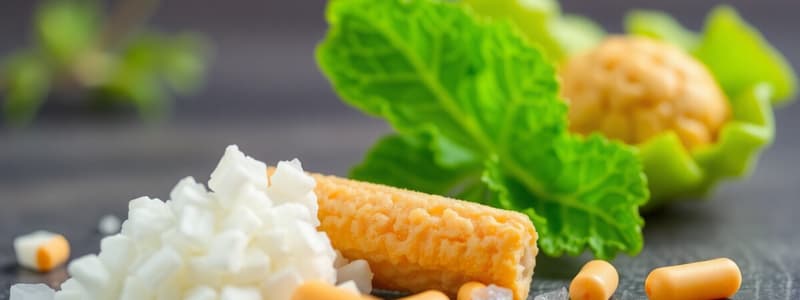Podcast
Questions and Answers
What is the main biochemical role of carbohydrates in the body?
What is the main biochemical role of carbohydrates in the body?
- Main source of energy (correct)
- Storage of proteins
- Production of hormones
- Regulation of body temperature
Which of the following classifications contains more than 10 sugar units?
Which of the following classifications contains more than 10 sugar units?
- Monosaccharides
- Disaccharides
- Polysaccharides (correct)
- Oligosaccharides
Which monosaccharide is primarily utilized by the tissues for energy?
Which monosaccharide is primarily utilized by the tissues for energy?
- Galactose
- Mannose
- Fructose
- Glucose (correct)
What is a key component of cellulose found in fibers?
What is a key component of cellulose found in fibers?
How are disaccharides formed?
How are disaccharides formed?
What distinguishes homopolysaccharides from heteropolysaccharides?
What distinguishes homopolysaccharides from heteropolysaccharides?
Which of the following is an example of a heteropolysaccharide?
Which of the following is an example of a heteropolysaccharide?
What is the primary function of starch in plants?
What is the primary function of starch in plants?
What are the two components of starch granules?
What are the two components of starch granules?
In which type of foods is starch commonly found?
In which type of foods is starch commonly found?
Flashcards are hidden until you start studying
Study Notes
Carbohydrates
- Organic compounds containing carbon, hydrogen, and oxygen.
- Ratio of hydrogen to oxygen is the same as in water.
Biochemical Importance
- Primary energy source for the body.
- Stored as glycogen in muscles and liver for later use.
- Cellulose, a component of fiber, promotes intestinal motility and waste elimination.
- Combine with lipids (glycolipids) and proteins (glycoproteins) to form structural components of cells.
- Food sources provide water-soluble vitamins and minerals
Classification:
- Monosaccharides: Single sugar unit, simplest carbohydrates
- Oligosaccharides: 2-10 sugar units
- Polysaccharides: More than 10 sugar units
Monosaccharides
- Simplest carbohydrates with one sugar unit.
- Classified by the number of carbon atoms:
- Trioses: 3 carbon atoms
- Tetroses: 4 carbon atoms
- Pentoses: 5 carbon atoms
- Hexoses: 6 carbon atoms, e.g., glucose, fructose, galactose, and mannose.
Hexoses
- Glucose: Grape sugar, blood sugar, primary energy source for tissues. Stored as glycogen.
- Fructose: Found in fruit juices and honey, fetal blood, and seminal fluid.
- Galactose: Component of lactose (milk sugar), paired with glucose.
- Mannose: Found in mucoproteins.
Oligosaccharides
- Formed by condensation of 2 to 10 monosaccharide molecules.
- Disaccharides are the most important group.
Disaccharides
- Formated by condensation of 2 monosaccharides:
- Lactose (Milk Sugar): 1 Galactose + 1 Glucose
- Sucrose (Cane Sugar, Beet Sugar, Table Sugar): 1 Glucose + 1 Fructose
- Maltose (Produced during Starch Digestion): 1 Glucose + 1 Glucose
Polysaccharides
- Composed of many monosaccharide units (more than 10) linked together.
- Homopolysaccharides: Contain only one type of sugar, e.g., starch, glycogen, cellulose, dextrins, dextrans, and agar-agar.
- Heteropolysaccharides: Contain different types of sugars, e.g., gums, pectin, and mucopolysaccharides.
Homopolysaccharides
- Contain similar sugar units
- Starch:
- Major carbohydrate in food.
- Primary storage form of carbohydrates in plants.
- Found in cereals (rice, barley, maize, wheat) and roots and tubers (potatoes, sweet potatoes).
- Not found in animals.
- Granule structure:
- Amylose: Inner layer, straight chain of glucose units.
- Amylopectin: Outer layer, branched chains of glucose units.
Starch Structure
- Starch granules are formed of amylose and amylopectin.
- Amylose forms the inner layer and is made of straight chains of glucose units.
- Amylopectin forms the outer layer and is composed of branched chains of glucose units.
Studying That Suits You
Use AI to generate personalized quizzes and flashcards to suit your learning preferences.



